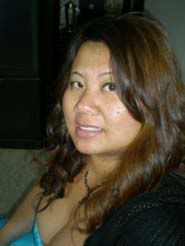A small, woollen-hatted woman, one of thousands of ethnic Hmong recently expelled from Thailand, creeps up to the row of rare foreign visitors in her new Laotian village.

Lao Hmong hill tribe villagers watch as foreign media and diplomats visit the village of Phongkham in Bolikhamsai province on March 26, 2010 where some 3,000 Lao Hmong were resettled after recently being deported from Thailand.
"I want to go to another country," she whispers to the diplomats and journalists, who have been invited by the communist government for a tightly-monitored trip to this remote, newly-built community.
"I don't feel good here in the village," says the 50-year-old, while the Laotian army's deputy chief, Brigadier General Bouasieng Champaphan, is delivering a rather different message to the audience.
"All the returnees are calm and stable and satisfied that they have returned to live in their home country again," he says. "They are very pleased and satisfied with the government's assistance."
Thailand faced a barrage of international criticism in December when it used troops to forcibly repatriate about 4,500 Hmong from camps in the country's north back to Laos, despite concerns of persecution on their return.
The Hmong's fear of retribution from the Laotian regime is a lingering remnant of the Vietnam War, when members of the ethnic hill tribe fought in a US-funded irregular army as the conflict secretly spilled into Laos.
After the communists took power in 1975, some Hmong hid in the jungle and fought a low-level insurgency against the regime. Hundreds of thousands of Lao and Hmong fled the country.
Though Thailand insisted all the Hmong recently sent back to Laos were illegal economic migrants, the United Nations recognised 158 of them as refugees, but was never allowed to assess if the thousands of others needed international protection.
While diplomats say there have been no reports of mistreatment, suspicions remain about the Hmong's rights and living standards in Phonkham village, which was built specifically for the group in central Bolikhamsay province.
"They've put them on a Laos equivalent of a desert island," said Phil Robertson, deputy Asia director of Human Rights Watch. "There's no sustained access to these people or quality of access."
Laotian officials said 3,457 of the repatriated Hmong were sent to Phonkham, while others went back to their home towns.
Laos said it would grant the international community's request for "free and unfettered" access to the returnees within 30 days of their repatriation, but so far visits have been scarce, brief and strictly monitored.
On the latest two-hour visit Friday, foreign diplomats, reporters and a few UN representatives were among those escorted in two helicopters from the Laotian capital Vientiane, a 45-minute flight away.
The delegation was ushered straight to an unfinished village hall to be greeted by smiling youngsters in traditional Hmong dress, before a briefing by central government and Phonkham officials.
"In the beginning of their resettlement... they were afraid because of not being familiar with their new environment and not understanding the Lao government's policies," said Bounthan Douangtanya of the village administration committee.
"But the authorities have conducted an education course for these returnees in order to... make them understand the policy regulations," he said, before detailing plans to develop the village infrastructure.
Diplomats were given a brief but revealing chance to question the 300 or so Hmong gathered in the hall.
How many had been outside of the village since arriving? One hand went up in response. How many had received money, parcels or anything else from contacts outside the village? Two. How many had yet received ID cards or official registration? None.
As the meeting ended, several of the Hmong approached their visitors, saying they wanted to leave. "I want to go to Canada," one 16-year-old girl told AFP, in English, as tears welled in her eyes.
She said she was one of the 158 recognised refugees who have been offered resettlement in Canada, the United States, Australia and the Netherlands. Embassies have been told by Laos that these people now want to stay.
One diplomat on the trip said that the Hmong who "explicitly" expressed a desire to leave "seemed to be demonstrating courage in coming to talk to us, despite the best efforts of the authorities to stage-manage the situation".
But the visit was "altogether not too bad," another Western diplomat said. "Obviously the transparency of the dialogue was limited," he added.
Brigadier General Bouasieng said foreign countries willing to assist the village should contact the government in Laos, which is one of Asia's poorest countries.
There are hopes that such aid, if allowed, would facilitate more openness about the Hmong.
"I think (the Laotian authorities) are going to struggle to support them. The trade-off is: if they want donations, they must give access," said Robertson of Human Rights Watch.
Rights groups say they have serious concerns about availability of clean water, food and medical treatment for the group.
"As long as access is strictly scripted and stage-managed, visitors will not be able to assess the well-being of the returnees," said Brittis Edman of Amnesty International.
Source
Read more...









